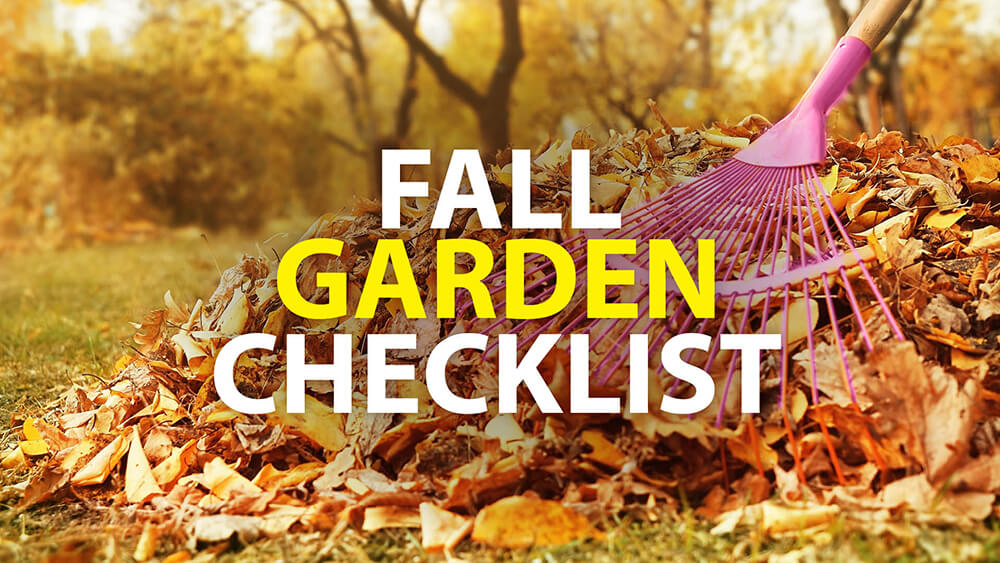Fall is officially here! The leaves are changing along with the seasons and we want to make spring as easy as possible for you. Get outside and enjoy that beautiful fall weather while you can by preparing your garden for next year.
Tidy up
The first thing you will want to do is tidy up your garden. The remnants of the past need to be cleared out so new growth can have a fresh start. Annuals have run their course and should be removed. As well, clean up any leaves that have dropped from the trees above and remove weeds before they set seed. Check around for any pests, insects, or eggs that you need to get rid of. Perennials can be trimmed back or you can opt to leave them until spring as they provide winter interest and food for wildlife. The seed heads of coneflowers, sunflowers, black-eyed susans and asters all provide tasty snacks for the birds.
Check pH and amend soil
Soil is often taken for granted but it really is the key to garden success. Think of it the same way as us eating healthy food versus junk food. Once you have finished cleaning everything up you should check the pH level of your soil. The pH level is really just a measure of how acidic or alkaline the soil is. The scale goes from 1.0 to 14.0 with 7.0 being neutral. Below 7.0 the soil is acidic and above 7.0 means it is alkaline. You should aim for a 6.5 pH level. Most plants grow best between 6.2 and 6.8 but not all plants. Why is the pH so important? It determines the availability of the nutrients in the soil to the plants. The texture of the soil is important too. The size of soil particles determines how fast the water drains and how long the soil can hold onto nutrients. Heavy, clay soil is comprised of small particles and is very slow draining. Sandy soil is made up of larger particles which are fast draining meaning that water runs right through and nutrients are not available to the plants for very long. You want to aim for a nice loamy soil which is fertile with lots of organic matter and has good drainage. Amending the soil is a two part process where you want to break up the soil which has likely compacted over time and add back any nutrients that may have been depleted. You can amend your soil with a 2” layer of organic matter such as composted manure, peat moss or topsoil. These will generally make the soil more acidic. Add lime if you want to raise your soil’s pH level. You can either use a tiller to work the compost in or simply turn the soil with a shovel. After this apply a fresh layer of mulch to prevent weed growth and help insulate plants through the winter months.
Plant spring flowering bulbs
If you have any bulbs that you want to plant, be sure to do so before the ground freezes. Bulbs are the perfect way to get started on your spring gardening. Bulbs that flower in the spring need to be planted now such as tulips, daffodils, alliums and crocus. Do the work now so you can sit back and enjoy those colourful spring blooms later!
Check trees and shrubs
Now is a great time to take a good look at trees and shrubs and see how they are doing overall.
Look for signs of insect damage and/or disease. Dormant spray which is typically applied in early spring can also be applied in the fall once the trees have gone dormant. This decreases the chance of insects overwintering. Also think about winter protection. Some shrubs require a winter wrap to prevent them from drying out or being eaten by deer and mice.
Clean and oil your tools
Cleaning your garden tools now will save you time in the spring when it seems there are a million tasks to do all at once. It will also get rid of any disease on them and help them to last longer. Physically remove any mud and plant debris then scrub with steel wool to remove rust. Next remove any sap and disinfect by wiping them down with isopropyl alcohol; once clean and dry, coat with a thin layer of vegetable oil to preserve the metal.
Clean your birdfeeders
Unfortunately it is time to put away your hummingbird feeders. Clean these thoroughly and put away until spring. It’s also a great time to clean regular seed bird feeders as well. Moldy, decomposing hulls can make the birds sick and droppings can spread disease between birds.
To clean your feeder, take it apart and soak in hot soapy water. Give it a good scrub and then disinfect in a solution of 1 part bleach to 9 parts water. Rinse thoroughly and let dry before refilling.
Enjoy the season
Get outside this fall and take advantage of the cooler weather to get a head start on the busy spring gardening season. But most of all enjoy yourself; breathe in the fresh air, feel the warmth of the sun on your face, listen to the cry of a blue jay in the distance and take in the spectacular display of changing leaves that Mother Nature has to offer.
Did you enjoy this article? If so, go ahead and join our
NEWSLETTER COMMUNITY

Why join our newsletter community?
-
Latest tips and tricks on gardening
-
Monthly articles
-
scottsnursery.tv latest episodes
-
Gift card giveaways

JOIN TODAY! ENJOY YOUR MONTHLY BENEFITS OF OUR NEWSLETTER.



Recent Comments